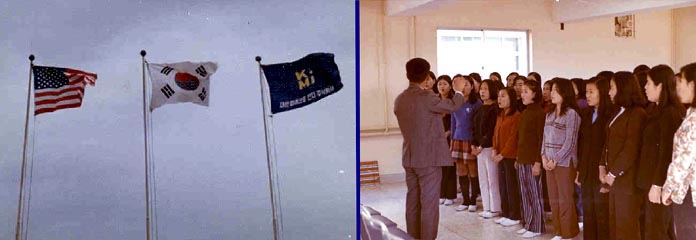| Early
KMI We
started
operation in late August 1970, but it took a few months for KMI
just to be
qualified by AMI due to an invisible contamination problem, which we
called "Ghost Contamination".
The initial qualifi- cation
samples that KMI sent to AMI for testing failed several times. AMI/KMI engineers
did their best to analyze failed parts to identify the cause of failure
but the cause was not easily found. It took a few months until they
finally discovered that the contamination was being caused by the floor wax we used.
Particles from the wax were floating around in the air after drying
and these invisible
clear particles contaminated the surface of
MOS-LSI (Engineers could not see them because they were
transparent), which were
burnt by very high temperature (420C) of Die Attach heater block.
Because the carbonized particles were conductive when they were
burnt, they were short circuiting the chip. We stopped using floor
wax and the green light to begin operation came from AMI in late December.
It
was the greatest Xmas Gift for KMI. KMI
experienced rough road of semiconductor business in second
year, or the first year of real operation - 1971. As KMI
demonstrated amazing yield improvement from the beginning of its
regular production, AMI changed its initial policy from building
only Ricoh's requirement at KMI to building all AMI's entire volume
in KMI, except what they could produce in Santa Clara Pilot Line.
This amounted to roughly 95% of total AMI volume, shutting their
Tijuana operation down (Tijuana had a very serious problem coinci-
dentally). KMI had to increase the capacity by more
than 5 times in less than 3 months, as Tijuana volume had to be transferred
to KMI before the contract with Tijuana company expired. That
is when KMI achieved yet another
MIRACLE. KMI hired
many new operators and trained
them 24 hours a day, with 3 shifts operation of Training Line. These inexperienced
new operators were added to production line at the fastest rate
possible. AMI believed it would be inevitable that our defect rate would
increase significantly, though it would only be temporary. HOWEVER,
KMI maintained its low defect rate throughout this entire period of
unreasonably fast capacity increase and
AMI management was once again amazed !! We
then encountered a problem toward the end of 1971. A worldwide
slowdown in the semiconductor
business forced AMI to reduce its volume
significantly. AMI laid off its people in Santa Clara and
requested KMI also to lay off about 1/3 of its operators, only a few
months after crazy hiring of new operators! We insisted AMI that
layoff of employees in Korea is unusual and that we would have serious
hiring problem in the future if we laid off our people, because KMI's
reputation in Korean society would be seriously damaged. We proposed
to lay off several more engineers there whose total salary would be
equivalent to 1/3 of our operators' total wages (Korean labor rate
was only 17 cents an hour at that time). We finally convinced
AMI to accept our proposal. There was no lay-off at KMI !!
Instead, KMI reduced volume switching normal 6 days a week operation to
4 days a week operation. After
this instance, I came up a crazy idea. Since we had to reduce
volume anyway, I proposed to Manny that we shut down KMI for 2 weeks and
send employees home to celebrate New Year with families. The
shutdown was not the crazy part of the proposal. What was crazy was
when I surprised Manny by proposing
to pay each employee a 1/2 month salary as a New Year Special Bonus to
help them return home! I still remember Manny's surprised face as he
looked at his crazy Plant Manager! An unplanned additional bonus
payment when AMI was asking us to lay people off was
really a crazy idea to me too. I
explained my logic to Manny : The total cost of Special
Bonus would be only several thousands of dollars - a small amount
compared to the total KMI cost, as the wage rate was very low in Korea at
that time. But the unexpected bonus should be a real bonus which
could buy the priceless loyalty of employees at a very low cost, especially when we
gave it in
appreciation of their hard work and excellent achieve- ment, in spite
of a very difficult company situation . It didn't take many words to
convince Manny and he said OK!! About
six months later, business turned around and AMI needed fast
increase of volume - faster than expected. KMI was able to respond to
AMI's demand without any delay, as all our people were well trained
by then and
everyone was ready to pay the company back for the special bonus
they had received with hard work and company loyalty. AMI/KMI was
able to recover the Special Bonus in just a few weeks
(or a few days?) as AMI was able to ship the entire requirement on time without any delay. In
addition, the loyalty of KMI employees lasted a long time. KMI
started another
project - ZD (Zero Defect) campaign. We
needed something to utilize the excess hours caused by a slow-down, rather
than to be depressed by it. The ZD Campaign was a very effective way to
forget the slowdown, to utilize much of the material down times and further to improve the yield of
operation. We had a very hard time
during the first half of 1972, but we
didn't waist this time and achieved better performance in the later
part of the year, constantly amazing AMI management.

Three
flags in KMI
KMI Chorus Team
led by Sec.
Manager Doo-Won Park |